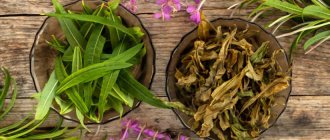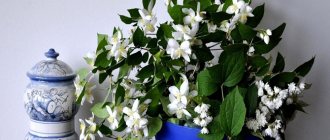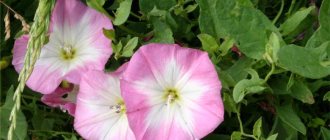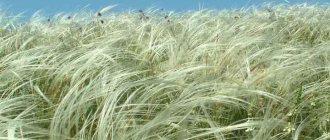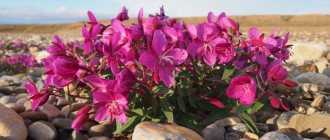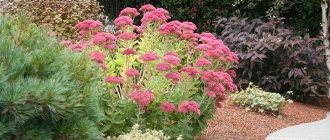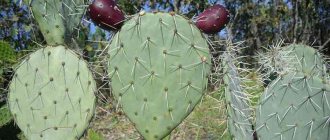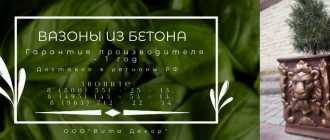Often the name Ivan-da-Marya is used in relation to several different types of plants. This is often the name given to meadow sage, tricolor violet, Geneva violet, and periwinkle, but a more well-known plant is oak grass. Its other names are Ivanets, two-colored or brother and sister.
This plant belongs to the broomrape family and is considered an annual. The Ivan-da-Marya flower is a honey-bearing and ornamental plant, but at the same time it is poisonous. Despite this, it is widely used in folk medicine.
Botanical description and photo of the Ivan-da-Marya flower
Mariannik oak grove is classified as a group of pharmacopoeial plants, that is, those with medicinal properties. However, it is not used in official medicine.
The Ivan-da-Marya flower is a semi-parasitic annual with a straight branched stem ranging from 15 to 50 cm in height. Opposite leaves are attached to it, sitting on very short petioles (1-2 mm). The entire plant is covered with short glandular white hairs.
The shape of the leaf blade is ovate-narrow-lanceolate. At the base it is rounded and heart-shaped, and at the end it forms a long point. The leaves are entire, slightly pubescent on top and profusely on the underside. The length of the plates varies from 3 to 10 cm, and the width from 0.5 to 4 cm. Teeth and ears may be present at the base of the leaves.
The semi-parasitic lifestyle of the oak grass is ensured by special suckers that form on the roots and are able to attach to neighboring plants in order to suck out nutrients from them. The hosts of Ivana da Marya can be trees, shrubs and even herbs. The height of its stem depends on who exactly the plant will be adjacent to.
Description of the flower
Ivan da Marya is an annual herbaceous plant that grows up to half a meter in height. The root system has specific suckers, thanks to which the flower attaches to other vegetation and lives on its juices. The erect stem, covered with white hairs, is characterized by branches. The ovate-lanceolate leaves are distinguished by their long-pointed shapes.
Each yellow flower is additionally decorated with a bract leaf of blue, violet, crimson or bright lilac color. At the end of the flowering period, which lasts throughout the summer, egg-shaped fruits are formed. Subsequently, the oblong seeds contained in the boxes serve as food for forest inhabitants.
Flowers and fruits
The flowers of the oak grass are collected in a group. By location, the inflorescence is apical and is a one-sided raceme, the length of which reaches 17 cm. The flowers sit on very short (up to 1 mm) pedicels and are surrounded by bracts that have a rich blue-violet color. The corollas themselves are bright yellow, which creates a beautiful contrasting effect.
In the photo, Ivana da Marya flowers look like a long patterned purple pole, hung with solar lights. Such a picture very often attracted the attention of painters and poets. When in the photo the Ivan-da-Marya flower blooms not in a single specimen, but in a group, then the area of the clearing, edge or forest canopy captured on camera looks like a variegated green-yellow-violet carpet.
We recommend reading: Useful properties and contraindications of horsetail
The bracts are smaller in size than the leaves (from 1 to 3 cm in length and up to 1.8 cm in width) and are often located on the stem. The edges of their plates are no longer solid, but comb-toothed.
Flowers of Ivana da Marya are zygomorphic, five-membered, with a two-lipped corolla (formula Ch(5)L(5)T(5)P(2)). At the base there is a cup that forms a 5 mm tube, from the top of which 4 long teeth with strongly pointed ends extend.
The flowering period lasts from May to September, and from June the fruits begin to ripen, which are oblong or elliptical-lanceolate boxes. They contain blackish seeds 5-6 mm long, which fall out as a result of bivalve opening.
Practical significance
Humans use the oak grass as a medicinal plant and an object for pharmacological research. The decorative nature of the Ivan da Marya flower gives it aesthetic value, but it is impossible to use it to create bouquets due to its rapid withering.
The oak grass is poisonous, therefore it can cause poisoning of livestock. Cows that eat this plant suffer from spoiled milk taste. If used carelessly for medicinal purposes, the flower becomes dangerous to humans.
In agriculture, oak grass is good as an insecticide. This plant is also of interest as a honey plant.
Contraindications for use
When faced with the need to use ivan da marya in treatment, it is always important to remember the toxic qualities of the herb . This primarily applies to oral use. Aucubin (glucoside rhinantine), contained in the seeds of the herb, has an irritating effect on the body, which is most often expressed by feelings of weakness, decreased cardiac activity, and constant drowsiness. If these symptoms appear after using drugs based on Ivan da Marya, be sure to consult a doctor.
Features of the chemical composition
Many pharmacopoeial, biologically active and toxic substances were found in the composition of the oak grass. First of all, these are flavonoids and phenolcarboxylic acids, among which the following were found:
- coffee shop;
- luteolin;
- ferulic acid;
- cinaroside;
- hyperoside;
- chlorogenic acid.
In total, the plant contains 9 varieties of flavonoids, the total content of which is 0.04-2.3%. Alkaloids and iridoids were found in trace quantities in the oak grove. The seeds contain the glycoside aucubin, which has toxic properties.
Application in medicine
Due to its poisonous nature, the oak grass is not used in official medicine, but in folk medicine this flower has been used for a long time. All components of the above-ground part of the plant are used as medicinal raw materials: stem with leaves, flowers and fruits. Harvesting is carried out during the flowering period by cutting or tearing out the shoot and subsequent drying.
We recommend reading: Beneficial properties of snakeweed and contraindications
Tinctures and decoctions are made from the dry material, which can be used both externally and orally, depending on the purpose of treatment. Due to the presence of toxic substances in the oak grove, care must be taken when taking it internally, as this can lead to poisoning. The latter usually manifests itself in drowsiness, weakness and weakening of cardiac activity.
Medicinal properties of the Ivan-da-Marya flower
Due to the biologically active substances contained in oak grass, this plant has a whole range of pharmacological properties, including:
- sedative;
- hypotensive;
- insecticidal;
- anti-inflammatory;
- cardiotonic;
- anticonvulsant;
- wound healing.
When taken internally, Ivan-da-Marya has a pronounced effect on the cardiovascular and nervous systems. It has been experimentally established that the tincture of this plant has effects similar to modern tranquilizers. In this case, the calming effect is associated with increased parasympathetic innervation. Thanks to these properties, oak grass is suitable for the treatment of the initial stages of epilepsy.
In folk medicine, tincture of Ivan da Marya has found quite wide application. It is recommended to be used for:
- hypertension;
- heart diseases;
- neurological pathologies;
- problems with the gastrointestinal tract;
- dizziness.
Externally, the tincture is used for various types of skin diseases (scabies, rash, eczema, etc.).
Collection and healing properties of herbs
The entire above-ground part of Ivan da Marya as a medicinal product The collection begins in late spring and ends in September. Initially, the collected material is dried in a well-ventilated area and subsequently stored separately from other herbs. It is also worth remembering that oakberry maryannik very quickly loses its qualities and is suitable for beneficial use during the first ten months.
In medicine, the herb is used as a wound healing and anti-inflammatory agent. The prepared decoction of Ivan da Marya is used for heart and stomach diseases. Adding a medicinal plant to baths helps get rid of rheumatism, eczema and skin tuberculosis.
Effective recipes using the flower:
- A decoction based on oak grass will help get rid of skin rashes, scabies or scrofula. To prepare, dilute 3 tbsp per liter of boiled water. spoons of medicinal herbs. After two hours, the infusion is filtered and added to the bath or used for local rubbing.
- To treat hypertension, heart disease, to get rid of frequent dizziness and epilepsy attacks, the concentration of ingredients changes. In this case, 1 tbsp. l. Ivan da Marya is poured with a glass of boiling water, left for about half an hour and filtered. For effective treatment, drink the decoction twice a day, half a glass.
- The crushed young plant, as well as Ivan da Marya powder, promotes rapid healing of wounds.
Article on the topic: All-leaved pigweed - beneficial properties, description
Ivan da Marya - indoor flower
There is another plant with the name Ivan-da-Marya - indoor begonia, popularly called the same as oakberry, although in fact these are 2 completely different biological species.
In the photo, the indoor flower Ivan-da-Marya looks like an unusually beautiful graceful plant with two types of corollas: rose-shaped and bud-shaped, which are always formed in pairs. This was the reason for such an original name, since on the territory of Russia plants with different flowers were designated by a phrase consisting of combined male and female names.
Maryannik oak forest was named Ivan da Marya for the same reason. However, in this case, the popular perception of the plant is very different from the scientific one.
Source
Legends about the flower
Nature has endowed the Ivan-da-Marya plant with a very bright and contrasting color, which is why there are so many different legends and tales around it.
Each nationality tells its own legend of the appearance of the flower, but in each story there were lovers who, in spite of everything, wanted to be together. So this bright flower became a symbol of fidelity and love. Since ancient times, it was believed that blue is a masculine color and yellow is a feminine color. But it is also not surprising that the name uses the most common Russian names - Ivan and Marya. They could symbolize any couple in love. The two most common legends are:
- The first tells about two lovers, whose names were Marya and Ivan. One day a couple went into the forest to pick mushrooms. And suddenly, unexpectedly, clouds gathered over them, it began to rain, the wind grew stronger, and lightning flashed. The girl was very scared, then Ivan covered her with himself. After the bad weather passed, the lovers went home. After some time, in the place where the guy hid his beloved, a yellow flower grew, and a purple leaf bent beautifully over it. It is this leaf that protects the fragile flower, like Ivan protects his Marya.
- There is another equally interesting legend about the flower. So, in a certain forest, a goblin lived alone, who had no friends, and he constantly scared people. But one day, while walking through the forest, he noticed a purple violet, which he immediately fell in love with. The goblin admired her, but she didn’t even look in his direction. One day he confessed his love to her and asked her to marry him, but the violet quietly turned away. Then the goblin began to promise all the stars from the sky, but the beauty said that she did not need anything from him. She was secretly in love with the beautifully blooming purple Ivanushka, who grew nearby. And these two beautiful violets got married and began to live side by side on the same stem. The goblin got upset and left.


